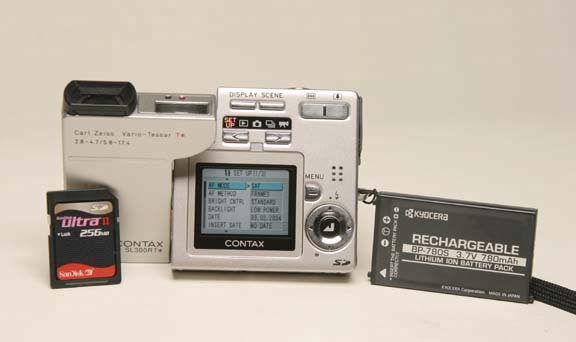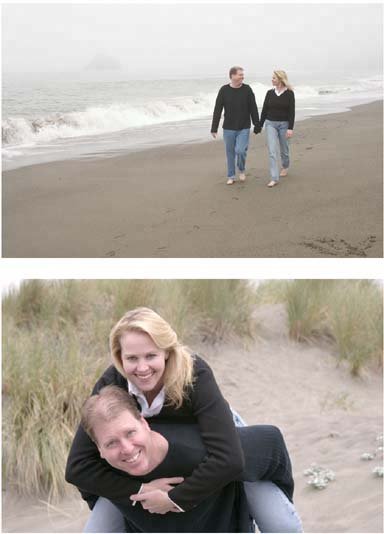3.8. Travel Photography Digital cameras are perfect vacation companions. Memory cards are easy to pack, there's no film for airport X-rays to wash out, and when the day is done, you can review all of your images on the camera's LCD screen, on your laptop, or on the hotel room TV. Shooting on the road presents unique photo opportunities that simply aren't available at homelike museums, fjords, and Cinderella's Castle. Here's how to master those moments and add a little spice to your vacation slideshow. 3.8.1. Packing up Digital cameras may be small and compact, but they're often accompanied by just as much accessory junk as film cameras. Here's a pre-trip checklist: -
Batteries .The laws of photography dictate that you'll run out of juice at the precise moment the perfect shot appears. If your camera comes with its own proprietary, rechargeable battery, consider buying a second one. Charge both batteries every night, and take them both with you during the day. (Pack the charger, too.) If your camera accepts AA-type batteries instead, you have much more flexibility. Bring your set of NiMH rechargeables, as described as Section 1.2.4, and their charger. Also pack an emergency set of disposables, like alkaline AAs or Duracell CRV3 lithium disposables, if your camera accepts them. -
Memory cards . Nobody ever said,"Oh, I wish I'd bought a smaller memory card." As a rough rule of thumb, figure that you'll wind up keeping 50 shots a day (not including the ones that you delete right off the camera). If you have a 4-megapixel camera, a 128 MB card might be enough for one day of shooting. If you brought a laptop on the trip, you can rush back to the hotel room each night and offload the pictures into iPhoto, freeing up the card for the next day's shooting. If you don't plan to take the laptop along, buy a much bigger memory card (or several). It's generally cheaper to buy two 256 MB cards than one 512 MB card, but shop around to get the best deal possible (www.shopper.com, for example). And if you plan to use the movie mode to capture video snippets of your adventures , then add one or two 1 GB cards to your kit. Memory-card prices are well below nosebleed territory these days; you can buy 1 GB cards for less than $75. -
Camera bag .If your camera didn't come with a case, get one for it. Not only will it protect your camera, but it will keep your batteries, cards, and cables together.
Tip: If you can find a camera bag that doesn't look like a camera bag, it's less likely to be ripped off. An insulated beverage bag does nicely , for example.
-
Tripod .Nobody likes to lug a tripod across Europeor across town, for that matter. But if you're a serious photographer, or aspire to be one, you'll occasionally need a way to steady your camera. A miniature tabletop tripod like the UltraPod 2 is an ideal compromise. It weighs only four ounces, costs $22, and provides solid support for your camera in a variety of situations. A quick search at www.google.com should help you find a mail-order company that carries it. Figure 3-12. Being prepared for travel mean packing extra memory and batteries. And don't forget the charger!  -
Weatherproofing . Keep a couple of plastic bags tucked in your carrying case for use in bad weather. Digital cameras hate water, but some of nature's most dramatic shows occur at the beginning and end of storms. -
Lens cloth . Microfiber lens cloths are light, inexpensive (about $5), and easy to packand they're the best way to keep your optics sparkling clean. They look like a regular soft cloth, but they actually have thousands of microfibers that grab smudges off your lens and whisk them away. -
Small flashlight . Don't risk losing a great night shot just because you can't read your camera's controls. Pack a small flashlight to help you work in dim lighting situations. 3.8.2. The Museum Challenge Many museums permit photography, provided you keep the flash off and don't use a full- size tripod. Digital cameras are particularly well suited to these assignments. Once you're in, here are some techniques to consider: -
You might want to increase the film speed setting to 200 or 400 to better handle the dimmer interior lighting (see Section 1.2.15). -
Museums often use halogen lightbulbs to illuminate the artwork, which could lend a red or yellow cast to your photos. If your particular camera automatically adjusts its color balance nicely, then no problem. But if your sample shots look too warm (reddish or yellowish), consider switching the camera's white-balance control to the Incandescent setting (usually denoted by a lightbulb icon on the control dial). If that doesn't improve the pictures, adjust the camera's white balance as described in Section 3.3.5 (if your camera offers this feature). -
How do you take a picture of what's in a glass display case without getting nasty reflections? The trick is to put the front of your lens barrel right against the glass. You'll probably have to zoom out all the way to frame the shot properly. -
Finally, hold the camera steady when shooting in museums. Because of the low lighting, your camera will probably choose a slow shutter speed, which introduces the possibility that the camera will shake, introducing blur. The steadier you hold your camera, the sharper your shots will be. 3.8.3. Portraits on the Road In standard headshots, you generally want to frame the subject as tightly as possible. But when you're traveling, you want to include the background so it might suggest your location. Unfortunately, many travelers include too much information about the location. In reality, sometimes you need two shots to convey one message. 3.8.4. Get Creative Picture taking should be fun while on vacation. You won't be graded on your shots; it's not a term paper to be turned in at the end of the week. So enjoy the process of shooting as much as the trip itself. Digital cameras encourage playfulness. You can try something silly, look at it on the LCD screen, andif it's too incriminatingerase it before anyone else discovers just how amateur an amateur photographer you really are. The bottom line: taking pictures should be part of your vacation. Figure 3-13. When you're taking portraits on location, vary your compositions. Include wide-angle shots, for example, to capture the environment as well as the subjects. Then move in closer for facial expressions. 
So here are a few ideas for you to try the next time you're exploring the world: -
Get in the picture . Almost every digicam comes with a self-timer. Position the camera so that you have an interesting background, trip the timer, and get in the shot. It's really fun if you're with a group , too. -
Try the close-up mode . Almost every digital camera offers a macro (super-close-up) mode that lets you get within inches of your subject. The world is a very different place at this magnification. Let your imagination run wild. Everything is a potential shot, from local currency to flower petals. -
Vary the shots . The standard shot of your travel companions standing posed in front of the Grand Canyon is fine, but that's only the beginning. The so-called "little shots," such as your son staring out the train window, or your friend buying flowers from a street vendor, are often more compelling than the typical "stand in front of a building and smile" photo. (See Figure 3-13 for an example.) -
The city lights from your balcony at sunset . There's a magic moment every day at twilight when the city lights come on right before the sun sets. Grab your camera, park it on a wall or windowsill for stability, and take a few shots. -
Shoot from the passenger-side window . Ask your travel companion to take the wheel as you drive along. Sitting on the passenger side of the car, roll down the window and look for interesting pictures. Don't worry about the background blurring and other little glitches, because they're often what make the pictures compelling. -
Signs and placards instead of notes . Museums, monuments, and national parks are all loaded with informative signs and placards. Instead of taking notes and lugging brochures , take pictures of these tidbits of information. When you put together your trip slideshow in iPhoto, these will make great introductory shots for each segment. -
Shooting through shop windows . Storefront displays say so much about the local culture. But taking pictures through glass can be tricky, thanks to unwanted reflections. As when shooting glass display cases in museums, the trick is to zoom out, and then get the front of the lens barrel as close to the window as possible. The closer you are, the fewer reflections you'll have in your picture. UP TO SPEED
Cautions on the Road | | Camera-toting tourists are prime targets for thievesand digital cameras make delicious loot. When you're on the road, keep in mind the following tips, which are designed to help you bring home more than just memories: -
Consider packing your camera gear in a backpack or a fanny pack instead of a traditional camera bag. That way, you're not walking through the streets of India with a bag that screams, "I'm an expensive camerasteal me!" -
Carry your camera bag onto the plane instead of checking it with the luggage. -
Secure the camera strap to your body when touring. -
Be wary when handing your camera to strangers for group shots. They may run away with it. Use the camera's self-timer to take pictures of yourselvesor at least use your best judgment in summing up passersby. -
Keep an eye on your equipment as you go through airport security. The best plan is to have your travel mate go through security first, then send through your collective equipment, then you go through. That way you always have someone close to your stuff. -
Don't leave your camera lying around your hotel room. If you leave it behind, put it in the room's safe. |
Now that you're armed with lots of ideas and techniques, you're probably getting the itch to take a vacation. When you go, don't forget your camera, a few memory cards, and plenty of battery power. |

